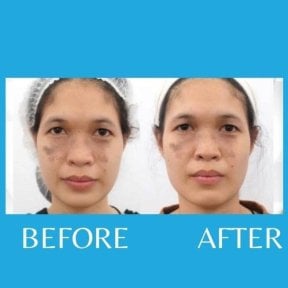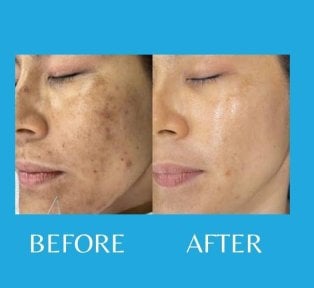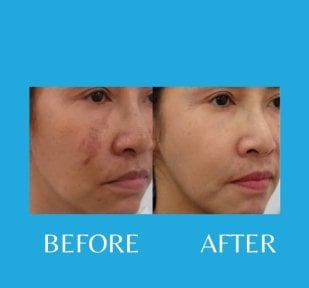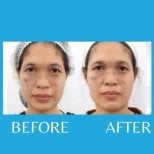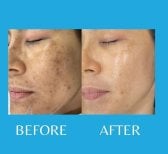- Dr. Phatcharasak Kraisornphongsakul Md is board certified in plastic surgery since 2000.
- ID Clinic Bangkok serves 4,000 patients annually from diverse international backgrounds.
- Included services: Video or text consultation, transfer to the clinic.
How it works
How Much Does Laser Skin Resurfacing Cost in Thailand?
The cost of laser skin resurfacing in Thailand typically ranges from $300 / ฿10,200 to $1,000 / ฿34,000. Prices vary based on the type of laser used (CO2, Er:YAG, or fractional), the size of the treated area, the clinic’s reputation, and the dermatologist’s experience. In the United States, the average cost is $3,000 / ฿102,000 (per ASPS). This means laser skin resurfacing in Thailand can be about 80% less than in the U.S.
Thai clinics often include the initial dermatologist consultation, the laser procedure, topical anesthesia, post-treatment creams, and a follow-up visit in the price. In the U.S., fees for anesthesia, aftercare products, and follow-up appointments are often billed separately. Always confirm exactly what’s included in your package before booking.
Key Benefits
- Opt for laser skin resurfacing in Thailand at 60-75% less than in the USA and Australia.
- Available options include Fraxel®, CO2 laser, and Erbium laser treatments.
- Free photo consultation by a specialist to determine the most suitable skin rejuvenation method for you.
- 100% data protection and confidentiality guarantee.
- Access exclusive offers from top Thai clinics from $155.
| Thailand | Turkey | The USA | |
| Laser Skin Resurfacing | from $263 / ฿8,942 | from $1,292 / ฿43,928 | from $2,000 / ฿68,000 |
| VBeam Laser Treatment | from $250 / ฿8,500 | from $350 / ฿11,900 | from $800 / ฿27,200 |
| MOXI Laser Treatment | from $1,500 / ฿51,000 | from $450 / ฿15,300 | from $1,800 / ฿61,200 |
| HALO Laser Treatment | from $1,900 / ฿64,600 | from $1,700 / ฿57,800 | from $3,500 / ฿119,000 |
| Fraxel Laser Treatment | from $300 / ฿10,200 | from $400 / ฿13,600 | from $1,500 / ฿51,000 |
Medically reviewed by
Fahad MawloodOur Laser Skin Resurfacing Packages in Thailand December 2025

- Dr. Sirintip Jira-adisai is a renowned specialist in anti-aging medicine and dermatology.
- ASIA CLINIC attracts patients from Europe, the Commonwealth, Asia, the USA, Canada, and Australia.
- Included Services: Video or text consultation, consultation with a doctor.
Discover the Best Laser Skin Resurfacing Clinics in Thailand: 4 Verified Options and Prices
Asia Cosmetic Hospital
Sirintip Jira-adsai
Dr. Chen Surgery Hospital International Center
Laser Skin Resurfacing in Thailand: Your Travel Plan
Day 1: Arrival in Thailand
- Upon landing in Thailand, you should arrange for airport pick-up if included in your package. Some clinics offer complimentary pick-up services upon a deposit.
- Check into your accommodation and rest after your journey.
- Review the itinerary provided by the clinic. It should include your consultation and procedure schedule.
- Contact the clinic to confirm your arrival and any appointments for the next day. This is also a good time to ask any last-minute questions.
Day 2: Pre-Procedure Consultation
- Attend the initial consultation with your surgeon. You will have a detailed discussion about your laser skin resurfacing procedure, such as Pico Discovery laser, and desired outcomes.
- Undergo a comprehensive physical examination. This may include blood tests, EKG, and X-rays to ensure you are fit for the procedure.
- Discuss any concerns or questions with the surgeon. This is a chance to clarify the recovery process and post-procedure care.
- Review and sign any necessary documentation or consent forms.
- Receive instructions on pre-procedure care, including any dietary restrictions or medications to avoid.
Day 3: Day of the Procedure
- Arrive at the clinic at the scheduled time. You should wear comfortable clothing and follow any pre-procedure instructions given by the clinic.
- The procedure will be performed under anesthesia, administered by a qualified anesthesiologist. The Pico Discovery laser will address your specific skin concerns.
- Post-procedure, you will be monitored in a recovery area. Depending on your package, you may stay in the hospital for 1 to 2 nights to ensure proper care and monitoring.
- Receive take-home medication and detailed post-operative care instructions.
- Utilize VIP nursing care and English translation services if needed to ensure clear communication with the medical staff.
Day 4: Post-Procedure Recovery
- Rest and follow the post-operative care instructions provided by the clinic. This may include applying prescribed creams or taking medications as directed.
- Avoid direct sunlight and use sunscreen as your skin may be sensitive after the laser treatment.
- Attend any scheduled follow-up appointments with the clinic to monitor your recovery and address any immediate concerns.
- Contact the clinic if you experience any unexpected symptoms or have questions about your recovery process.
Day 5-6: Continued Recovery and Follow-Up
- Continue to follow the recovery guidelines provided by the clinic. This includes maintaining a gentle skincare routine and avoiding strenuous activities.
- Attend any additional follow-up appointments as scheduled. These appointments are crucial for tracking your healing progress and ensuring optimal results.
- Utilize the clinic’s offered follow-up services for up to 6 months post-surgery, as needed, to address any ongoing concerns or questions.
Day 7: Preparation for Departure
- Ensure you have collected all necessary documentation and post-care instructions from the clinic.
- Confirm your departure arrangements, including transportation to the airport if included in your package.
- Reflect on the recovery process and make note of any questions or concerns to discuss with your surgeon during follow-up consultations.
Day 8: Departure from Thailand
- Check out of your accommodation and travel to the airport for your return flight home.
- Continue to follow post-procedure care instructions and schedule follow-up appointments with your local dermatologist or healthcare provider as recommended by the clinic.
- Maintain communication with the clinic for any additional support or questions regarding your recovery and results.
Bookimed, a leading global medical tourism platform, is committed to helping clients looking for Laser Skin Resurfacing in Thailand by offering expert assistance and trustworthy medical solutions for every situation. Smart automatic ranking system is used to compose transparent clinic listings, meticulously maintained by a data scientist using AI for accuracy. The platform guarantees authenticity by publishing reviews from real patients after their treatments. Bookimed offers comprehensive medical solutions, with updates from clinics to ensure trustworthiness. The content about Laser Skin Resurfacing in Thailand, crafted by experienced medical authors and reviewed by specialists, adheres to Bookimed"s Editorial Guidelines, reflecting the platform"s commitment to delivering high-quality and clear health information. For more details or inquiries, feel free to contact us at marketing@bookimed.com or learn more about us and our mission here.
Our Trusted Doctors
View all DoctorsPimpa Tantanasrigul
Doctor Sirintip Jira-adisai
Anchalee Amornrungmittham
Chakraphan Singhlomanthien
Video Stories from Bookimed Patients
Reviews about Bookimed: Discover Patients' Insights
All reviewsLaser Skin Resurfacing: Before & after photos
View allShare this content
FAQ about Laser Skin Resurfacing in Thailand
Is Thailand a good place for Laser Skin Resurfacing procedure?
Based on reviews and data from Bookimed, Laser Skin Resurfacing in Thailand is a great option for those seeking high-quality medical services in Aesthetic medicine and cosmetology, Dermatology, and Plastic Surgery.
- Thailand offers experienced board-certified doctors and state-of-the-art advanced surgical techniques from Korea, ultrasound technologies, and natural healing processes to lift and tighten skin.
- Clinics like B. Care Medical Center, Nirunda, and Bellamode Clinic have a high success rate for Laser Skin Resurfacing.
- Bookimed is a medical tourism company that is helpful in coordinating appointments and providing timely feedback.
- Chiangmai Ram Hospital is a well-known medical facility that offers high-quality medical services and treatment, as confirmed by the Joint Commission International.
- Rinrada Clinic is another single-specialty medical facility located in Pattaya, Thailand, that specializes in Aesthetic medicine and cosmetology. The medical team is professional, thorough, friendly, and welcoming, making patients feel comfortable and well-taken care of.
- Patients from the United States, Canada, the UK, and other countries choose Thailand for Laser Skin Resurfacing due to its high-quality medical services.
How long does it take to get Laser Skin Resurfacing in Thailand?
Which hospital is best for Laser Skin Resurfacing in Thailand?
Bookimed's rating has revealed the top 5 hospitals in Thailand for Laser Skin Resurfacing:
- Nirunda
- Bellamode Clinic
- Healthy Skin Clinic
- Rinrada Clinic
- Chiangmai Ram Hospital
Who is the best Laser Skin Resurfacing doctors in Thailand?
Bookimed has identified the top doctors in Thailand who excel in performing Laser Skin Resurfacing:
- Anuchit Kitsombat, Aesthetic Medicine and Cosmetology, 23 years experience
- Amorn Poomee, Aesthetic Medicine and Cosmetology, with 5.0 reviews score
- Ajchariya Sarovath, Aesthetic Medicine and Cosmetology
- Akkavich Harnnavachok, Aesthetic Medicine and Cosmetology, 12 years experience
- Siripong Prasertsuntarasai, Aesthetic Medicine and Cosmetology, 15 years experience
How does the cost of Laser Skin Resurfacing in Thailand compare to other countries, excluding the actual procedure price?
The overall cost of Laser Skin Resurfacing in Thailand is often lower than in Western countries due to reduced living expenses and healthcare costs. However, consider additional expenses like travel, accommodation, and potential follow-up care when budgeting for your procedure abroad.
What should I do if I experience complications after returning home from my procedure in Thailand?
If complications arise post-procedure, contact your Thai clinic immediately for advice. They may offer virtual consultations to assess your condition; however, seeking prompt local medical attention is crucial if severe symptoms occur.
Are there any hidden costs associated with having Laser Skin Resurfacing done in Thailand that I should be aware of?
While procedure costs are typically transparent, additional expenses may include medications, special skincare products, or extended follow-up care. Always request a detailed breakdown of costs beforehand to avoid unexpected charges.
What kind of support is available for international patients before, during, and after the procedure in Thailand?
International patients often receive comprehensive support including pre-treatment consultations via video or text, assistance with travel planning, and post-procedure virtual follow-ups. Clinics may also provide coordinators to help navigate language barriers and logistical arrangements.
How can I verify the qualifications and experience of the surgeons offering Laser Skin Resurfacing in Thailand?
Verify surgeons' qualifications by checking their board certifications and memberships in professional organizations such as the ISAPS. Additionally, request information on their training background and years of experience specifically in laser skin treatments.
What is the typical recovery time for Laser Skin Resurfacing, and how should I plan my stay in Thailand accordingly?
Recovery time varies depending on the intensity of the treatment but generally ranges from 7 to 14 days. Plan to stay in Thailand for at least a week post-procedure to allow for initial healing and follow-up appointments with your doctor.
Are there any specific travel arrangements or accommodations recommended for patients undergoing this procedure in Thailand?
While accommodation is not included in the procedure package, it's recommended to stay near the clinic for convenience during follow-up visits. Consider booking accommodations that offer easy access to transportation and are close to medical facilities.
How do I manage post-procedure care and follow-ups once I return home from Thailand?
Post-procedure care includes avoiding sun exposure, using prescribed creams, and keeping the skin moisturized. Many clinics offer virtual follow-up consultations via video calls to monitor your recovery and address any concerns after you return home.
What should I consider when choosing a surgeon for Laser Skin Resurfacing in Thailand?
Choose a surgeon who is board-certified, has extensive experience with laser procedures, and specializes in dermatology. Reviewing before-and-after photos of previous patients and reading testimonials can also provide insight into their expertise.
Will there be a language barrier when communicating with the medical staff in Thailand?
Many clinics catering to international patients have English-speaking staff and provide translators if needed. It's advisable to confirm language services during your initial consultation to ensure clear communication throughout your treatment.
How can I ensure that the clinic in Thailand is reputable and follows international standards?
To ensure a clinic's reputation, look for certifications from recognized organizations like the ISAPS or Joint Commission International (JCI). Research patient reviews and verify that the clinic employs board-certified dermatologists with extensive experience in laser procedures.
What are the potential risks and side effects of undergoing Laser Skin Resurfacing in Thailand?
Laser Skin Resurfacing carries risks such as redness, swelling, and temporary changes in skin color. In rare cases, infection or scarring might occur, but these can be minimized by following post-procedure care instructions. Always consult with a board-certified dermatologist to discuss your specific skin type and risk factors.
What should you know about Thailand before the trip?
Official name | The Kingdom of Thailand |
Currency | Thai Baht (you also can pay for services in dollars) |
Best period for the trip | November-early April |
Language | Thai (most of medical staff speaks English fluently) |
Visa | is required for a trip of 3-6 months |
Time difference with Europe | 7 hours |
Time difference with the USA | 12 hours |
Capital | Bangkok |
Medical tourism center | Bangkok |
Popular resorts | Koh Samui, Phuket, Chiang Mai, Koh Chang, Hua Hin |
What is the level of medicine in Thailand?
Healthcare is the key development sector of the Thai government. The Thai authorities are convinced that care for the citizens' health should be an absolute priority of state policy and spend about 25 billion baht for healthcare annually.
As a result, 36,673 medical facilities provide excellent medical care in the country. 64 centers in the Kingdom have certificate of JCI (Joint Commission International), the international improver of healthcare quality and safety across the globe. The index of certificates obtained is the largest. To compare, Israel has 20 JCI-accredited facilities, and Germany — only 10 clinics of this type.
What hotel service is provided here?
In the Kingdom of Thailand, hotels of different price ranges and service levels are presented. The level of Thai hotels is comparable to hotels in Tunisia, Morocco or Egypt. Most tourists choose 4 and 5 star hotels with all-inclusive meals. Such hotels have everything for a comfortable stay: varied food, a large well-groomed territory, animation for children and adults. Some hotels have their own water park, which guests can use for free. Budget travelers can afford to book an economical 3-star hotel with half board or no meals at all.
When is the best time to travel to Thailand?
The main advantage of Thai resorts is the long beach season. On the east coast and west coast the climate features are different, so take it into account when planning the trip. The best time to travel is during the cool and dry season between November and early April. A large influx of tourists is in March-May, when the air temperature is +30°C.
Do I need a visa?
For now, the Kingdom of Thailand requires different visa regimens for diverse states. Some foreigners can stay in the country 60 days without visa control, some of them — only 14 days.
How long you can stay in Thailand and what countries can cross the border easy read here.
What documents are required to apply for a visa to Thailand for treatment?
Visas for travel to Thailand require a number of documents. The necessary papers can be submitted 90 days before the planned departure. The list of documents includes:
- ID card
- confirmation of online registration and filling out the questionnaire
- certificate of income and availability of funds (20,000 baht per person/40,000 baht per family)
- insurance policy for a stay in Thailand (original and copy)
- 2 photos (4x6)
- visa receipt
- booking of round-trip air ticket (paid in full) and hotel
- medical opinion about the need for treatment.
